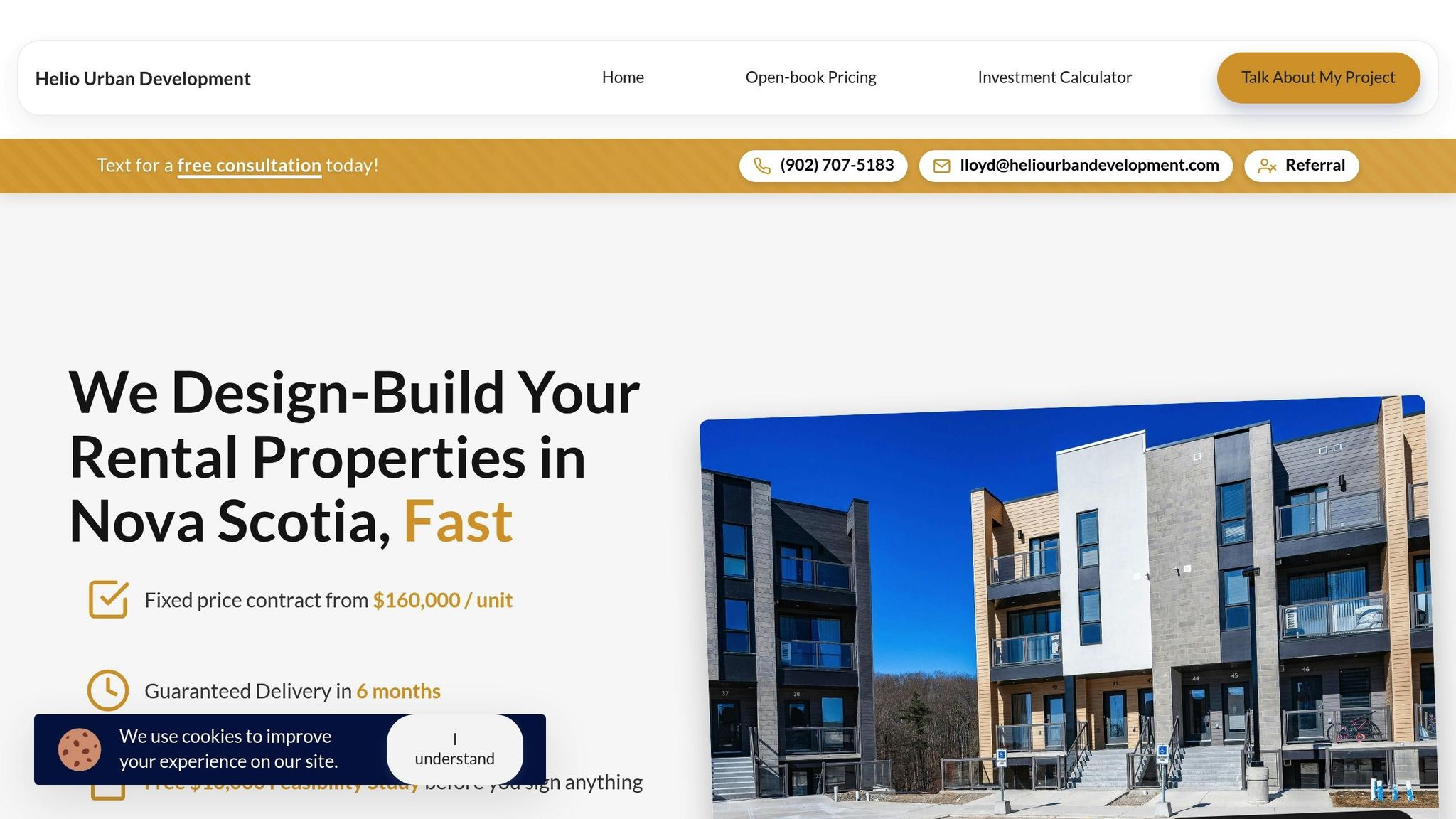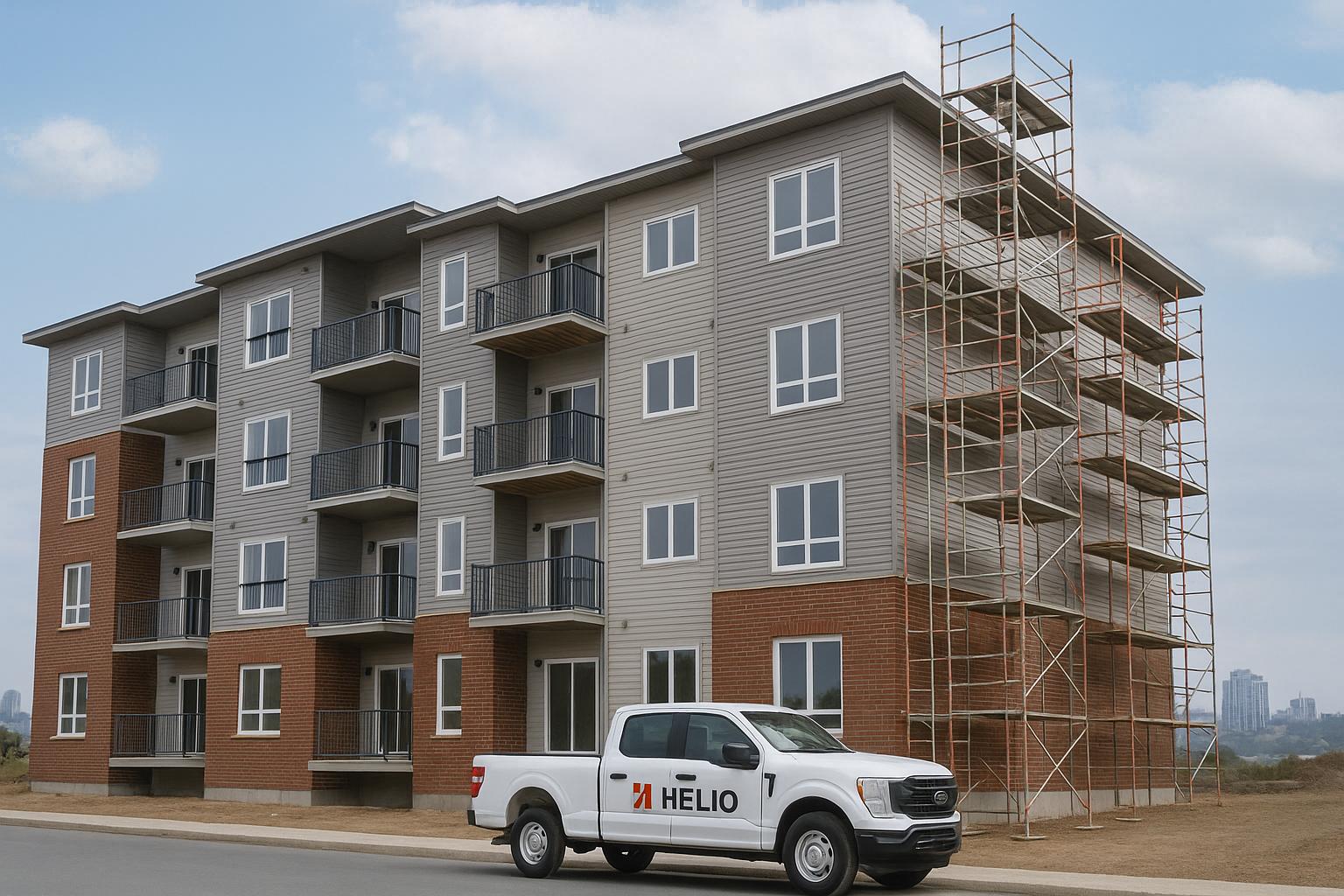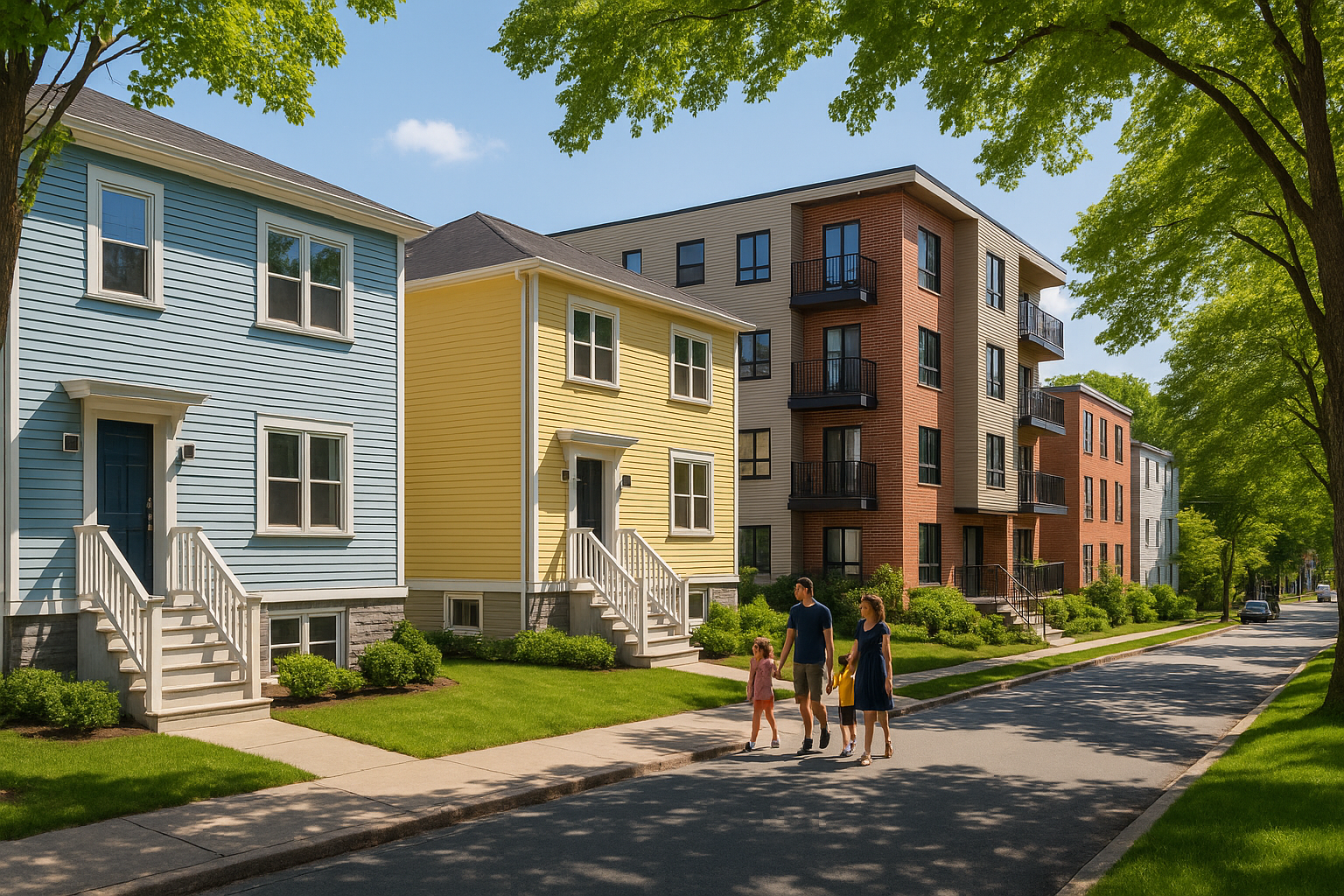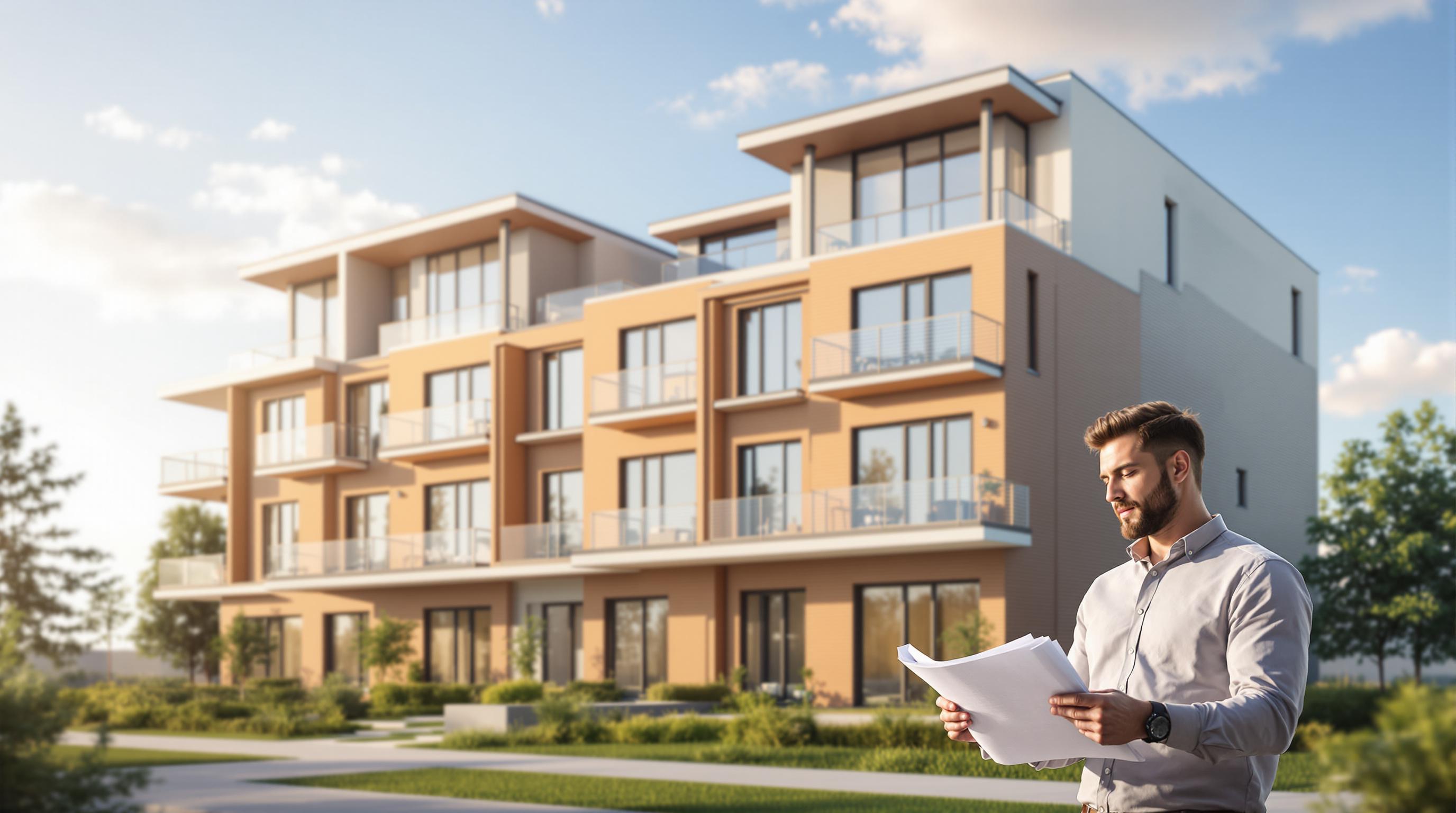Three-storey walk-up apartments are a smart choice for Halifax Regional Municipality (HRM) property owners. They balance cost-efficiency, tenant appeal, and zoning compliance, making them ideal for mid-density housing in a competitive rental market. Here's why:
- Cost-Effective Construction: At about $160,000 per unit, these buildings are cheaper to build than high-rises, while still offering solid returns. Monthly rents for two-bedroom units range from $1,950 to $2,100, with potential annual returns of 12% to 20%.
- Tenant Appeal: Two-bedroom layouts are highly sought-after by young professionals, small families, and couples. Features like in-unit laundry, private balconies, and energy-efficient upgrades attract long-term renters.
- HRM Zoning Compatibility: These buildings align with height restrictions and medium-density zoning rules, especially in areas near transit, universities, and employment hubs.
- Streamlined Construction: Integrated design-build methods reduce delays, cut costs, and ensure projects are completed in six months, with fixed pricing and daily progress updates.
For HRM property owners, three-storey walk-ups offer a practical, profitable way to meet growing rental demand while keeping costs under control.
Best Unit Layouts and Tenant Features
Best Unit Mix for Maximum Income
In Halifax Regional Municipality (HRM), focusing on two-bedroom apartments can strike an ideal balance between rental income potential and tenant appeal. These units are popular with young professionals, small families, and couples, offering the space and flexibility they need. A well-thought-out mix - primarily two-bedroom units with a smaller number of one-bedroom and efficiency apartments - can help maintain high occupancy rates while maximizing rental income. To further increase demand, consider placing two-bedroom units in sunlit, corner locations on upper floors, as these features often justify higher rents.
This thoughtful layout provides the foundation for in-unit features that tenants value most.
Must-Have In-Unit Features
Modern tenants look for features that make their living spaces comfortable and convenient. Key amenities include in-unit laundry facilities, which not only simplify daily life but also encourage tenant retention. Outfitting units with full-size stainless steel appliances, durable and attractive countertops, and ample storage space can help justify premium rents.
Adding private outdoor areas, such as balconies or small patios, offers tenants a personal retreat to enjoy the outdoors. Additionally, pre-wiring units for fibre internet is a must, as fast and reliable internet is essential for remote work and entertainment.
Pairing these features with energy-efficient and accessible designs can further elevate tenant satisfaction.
Energy Efficiency and Accessibility Features
Energy-efficient upgrades not only reduce operating costs but also attract tenants who value sustainability. Installing ductless heat pumps provides cost-effective, zoned heating and cooling, while triple-pane windows improve energy efficiency and enhance overall comfort.
Incorporate LED lighting with dimmers, energy-saving appliances, and programmable thermostats to help tenants save on utilities. Accessibility is equally important - features like wider doorways and thoughtfully designed bathrooms can make units welcoming to a broader range of tenants. Plus, these elements may qualify for government incentives, making them a smart investment for property owners.
HRM Zoning Rules and Site Requirements
HRM Zoning Rules for 3‑Storey Buildings
The Halifax Regional Municipality (HRM) has zoning rules designed to balance the development of higher-density multi-unit buildings with the preservation of neighbourhood character. In most residential zones within HRM, three-storey walk-up apartments are permitted, provided they adhere to regulations concerning height, setbacks, lot coverage, parking, and density. To ensure compliance, property owners should review the most up-to-date HRM bylaws relevant to their project.
Lot coverage regulations dictate how much of the land can be developed, leaving room for green spaces and outdoor amenities. Parking requirements are another key factor, varying by zone, but generally ensuring enough space for vehicles and circulation. Density is often controlled through floor area ratio (FAR) limits, which help maintain a medium-density scale that aligns with the surrounding neighbourhood.
Grasping these zoning requirements is essential when choosing a site that satisfies both legal guidelines and market expectations.
How to Choose the Right Site
When selecting a site, keeping zoning rules in mind is just the beginning. The location's access to transit, amenities, and other conveniences can make or break the success of a project. A well-chosen site not only reduces construction costs but also attracts reliable rental income. Properties close to public transit, employment hubs, and popular amenities like universities are more appealing to tenants. For instance, areas with easy transit access or a short commute to downtown or major employment centres tend to command higher rents and maintain lower vacancy rates.
Additionally, the site's topography and access to utilities play a big role in controlling costs. A location with favourable grading and utility connections can significantly lower expenses related to foundation work and site preparation. Opting for a site in a neighbourhood that already supports similar density developments can also streamline the approval process and reduce the likelihood of local opposition.
HRM Permit Process Step-by-Step
The HRM permitting process begins with a pre-application consultation, followed by public consultation and the creation of a development agreement. Property owners must submit a detailed site plan that addresses grading, drainage, parking, and landscaping. Afterward, they need to provide thorough permit applications, which include structural, mechanical, electrical, and fire safety drawings and reports. Inspections are conducted at various stages of construction to ensure compliance.
Partnering with professionals experienced in HRM’s permitting requirements can make the process smoother. This expertise can help avoid delays caused by issues like incomplete documentation or utility coordination challenges. By following this structured approach, property owners can successfully develop apartments that align with market needs and local regulations.
Best Configurations for Profit and Tenant Appeal
How Many Units and What Floor Plans
To strike the right balance between tenant appeal and profitability, aim for buildings with six to twelve units, ideally with two units per floor. Two-bedroom layouts are especially popular, drawing in young professionals and small families. These layouts not only meet local zoning requirements but also maximize rental income. Designing spaces that feel open and welcoming further enhances tenant satisfaction, making the property more appealing. With these configurations in place, you can better evaluate cost-effective options for parking solutions.
Surface Parking vs Underground Parking
When it comes to parking, surface parking is the more budget-friendly choice, keeping construction costs lower. On the other hand, underground parking, while pricier, is often a better fit for high-density areas with expensive land values. Choosing between these options depends on the local market and the specific needs of the neighbourhood. The parking ratio you settle on will have a direct impact on the financial viability of your project, so careful consideration is key.
Construction Costs and Rent Numbers
Expect construction costs to average around $160,000 per unit. For two-bedroom units, monthly rental rates typically range between $1,950 and $2,100, offering annual returns of 12% to 20% with proper management. Adding features like quartz countertops, engineered hardwood floors, ductless heat pumps, and triple-pane windows not only boosts tenant appeal but also attracts reliable renters.
Investing in energy-efficient upgrades may increase upfront costs, but they significantly lower utility expenses and help maintain long-term occupancy. Financing programs like CMHC MLI Select can also ease initial financial burdens, though the per-unit cost under such schemes might rise to approximately $200,000.
sbb-itb-16b8a48
Why Choose Integrated Design-Build Construction
Traditional Construction vs Integrated Construction
When it comes to building multi-unit projects in HRM, many property owners run into the same issues: uncoordinated efforts, budgets that spiral out of control, and project timelines that stretch far beyond expectations. A project meant to take eight months can easily balloon to over 18 months, with costs overrunning by 30–60%. Why? Traditional construction relies on a fragmented system where property owners juggle multiple professionals - architects, engineers, contractors, subcontractors, and specialists - each working independently.
Here’s a quick comparison to show the difference between traditional and integrated construction:
| Traditional Construction | Integrated Construction |
|---|---|
| Multiple contracts with various companies | One contract with a single company |
| Cost-plus pricing with frequent overruns | Fixed pricing locked in before construction begins |
| 12–18 month construction timelines | Guaranteed 6-month completion |
| No clear accountability for problems | One accountable point of contact |
| Property owner manages all trades | Teams collaborate under one roof |
| Reactive problem-solving | Proactive, systematic delivery process |
Integrated design-build construction simplifies the process by consolidating everything under one roof. Instead of managing several contracts and professionals, property owners work with one company that handles every stage - from initial design to final construction.
How Integration Fixes Common Construction Problems
The traditional construction model often suffers from inefficiencies that add up. Miscommunication, scheduling conflicts, and uncoordinated design changes can cost around $47,000 per project. These issues arise because independent teams don’t always work in sync.
Integrated construction resolves these challenges by uniting all project teams. Imagine the architect designing your building sitting just a few desks away from the engineer calculating its structural loads and the construction manager coordinating the trades. This close collaboration helps solve potential problems before they escalate into costly delays.
This approach also guarantees a 6-month completion timeline with fixed pricing, removing the risk of unexpected expenses. By addressing potential issues during the design phase - when solutions are far cheaper - integrated teams prevent the kind of surprises that can derail traditional projects. These principles are central to the way Helio Urban Development operates.
Helio Urban Development's Approach

Helio Urban Development has taken the integrated design-build model to the next level, delivering a seamless solution for property owners. As Nova Scotia’s only integrated design-build firm focused on 4+ unit rental properties, Helio addresses the key pain points property owners face: coordination chaos, budget overruns, and timeline delays.
Helio was founded by Lloyd Liu, a former Merrill Lynch investment banker who experienced the frustrations of construction delays firsthand, and Yuan He, a data scientist from the University of Pennsylvania. Together, they’ve built a company that tackles these challenges head-on.
"I personally guarantee every timeline because I've felt the pain of construction delays", says Liu, who oversees $30M+ in construction projects and reviews every quote himself.
Helio’s systematic approach ensures fixed-price construction at $160,000 per unit, with a 6-month guaranteed timeline. If they miss that deadline, they pay penalties of up to $1,000 per day. This guarantee is made possible by an advanced scheduling system developed by Yuan He after their first project suffered delays.
"Our scheduling system prevents the delays that killed our first construction project", explains He. Thanks to this technology-driven approach, Helio has reduced typical 12–18 month timelines to just 6 months.
Transparency is another cornerstone of Helio’s process. Property owners receive daily photo updates through a real-time project portal, eliminating the guesswork that often accompanies traditional construction. Instead of waiting weeks for updates, owners can track progress every single day.
Helio also ensures triple quality verification. Professional Engineers inspect the project five times during construction, and property owners have the final say by choosing their own inspector. This rigorous quality control is backed by a 2-year warranty, giving owners confidence that their investment is built to last.
Currently, Helio has 31 units under construction across Nova Scotia, with 131 more in the planning stages. They work exclusively with property owners within 90 minutes of Halifax, helping them build profitable three-storey walk-ups - without the usual construction headaches.
Conclusion: Building Profitable Apartments That Tenants Want in HRM
Key Takeaways
Three-storey walk-up apartments strike a smart balance between generating rental income and keeping costs manageable for property owners in HRM. These buildings are a practical choice, offering strong cash flow without the added complexity and expense of high-rise construction.
The best setup often includes a mix of two-bedroom units, which not only provide solid returns but also appeal to a broad range of tenants. Thoughtful design decisions can attract higher-paying tenants while keeping operational costs in check.
HRM’s zoning rules often favour three-storey buildings, especially in residential areas, making site selection easier despite height restrictions. Locations near transit, universities, downtown hubs, or major employers are ideal for maintaining steady rental demand.
Using an integrated design-build approach simplifies the construction process. Instead of juggling multiple contracts and dealing with unpredictable budgets, property owners benefit from fixed pricing - $160,000 per unit - and guaranteed completion within six months. This streamlined process makes it easier to move forward with confidence.
Next Steps for HRM Property Owners
The advantages of this approach make it clear: if you’re planning a three-storey walk-up project, securing the right construction partner is crucial before locking in your site. Traditional methods often lead to budget overruns of 30-60% and project delays stretching from 8 months to over 18 months - delays that can cost property owners thousands in lost rental income.
Helio Urban Development offers a reliable alternative for property owners within 90 minutes of Halifax. With 31 units currently under construction and 131 more in the pipeline, they’ve proven their ability to deliver projects on time and within budget. Their fixed pricing of $160,000 per unit, paired with quality finishes and a six-month completion guarantee, ensures you can begin collecting rent as scheduled.
Helio’s approach eliminates common challenges like coordination issues, cost overruns, and delays. They provide daily photo updates through a real-time project portal and enforce triple quality checks with inspections by Professional Engineers throughout the build.
For property owners ready to take the next step, start by assessing your site and financial goals. Whether you choose standard construction or leverage the CMHC MLI Select program for additional financing benefits, working with an experienced design-build partner can help turn your three-storey walk-up into a profitable, tenant-friendly investment in HRM’s competitive rental market.
FAQs
Why are three-storey walk-up apartments a smart choice for property owners in the Halifax Regional Municipality?
Three-storey walk-up apartments come with several perks for property owners in HRM. For starters, they’re generally less expensive to build and maintain compared to high-rise buildings. This means lower operating costs, which can help keep rental prices competitive - a big plus in the local rental market.
Another advantage is their neighbourhood-friendly vibe. These buildings tend to fit seamlessly into residential areas, appealing to renters who value a sense of community. On top of that, the zoning and permitting process for three-storey developments is often more straightforward, giving property owners more flexibility to make the most of their land while staying compliant with local rules.
What are the advantages of the integrated design-build approach for property owners, and how does it solve common construction challenges?
The design-build method streamlines construction by merging design and construction services into a single contract. This eliminates the hassle of juggling multiple agreements and provides one clear point of accountability, cutting down on miscommunication and potential delays.
Unlike traditional methods, this approach delivers more predictable costs through fixed pricing, speeds up project timelines with smoother coordination, and minimizes unexpected issues during construction. For property owners in Halifax, this means a more efficient and reliable process, making it easier to plan ahead and optimize their investment.
What zoning rules should I consider when planning a three-storey walk-up apartment in the HRM, and how do they influence site selection?
When designing a three-storey walk-up apartment in the Halifax Regional Municipality (HRM), it's crucial to understand the ins and outs of ER-3 zoning requirements. This zoning typically allows for up to eight units per lot. However, the final number hinges on factors like minimum lot size and frontage requirements, which depend on the type of dwelling you're planning.
These zoning rules play a big role in choosing the right site. Not every lot will meet the standards for multi-unit developments, so it's important to evaluate the lot's dimensions and ensure they align with zoning regulations early in the process. Taking the time to do this upfront can help avoid unnecessary delays and ensure the project stays on track. Working with local experts who know HRM zoning regulations can make a big difference, helping you find the right property and sidestep expensive mistakes.
Related Blog Posts
- Build 4-8 Units Halifax: ER-3 Height Limit 11 Meters Explained
- Halifax 3-Storey Apartments: ER-3 Maximum Height Without Variance
- Halifax Backyard Suite Plus 4 Units: ER-3 Maximum Development
- ER-3 (ER3) Builder Halifax: How Many Units Fit on a Typical Lot?Halifax Apartment Builder: 4–12 Units Without Rezoning



